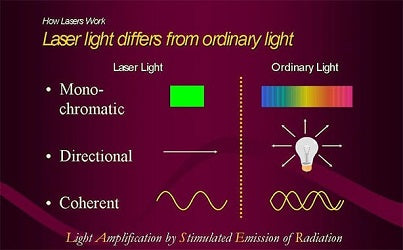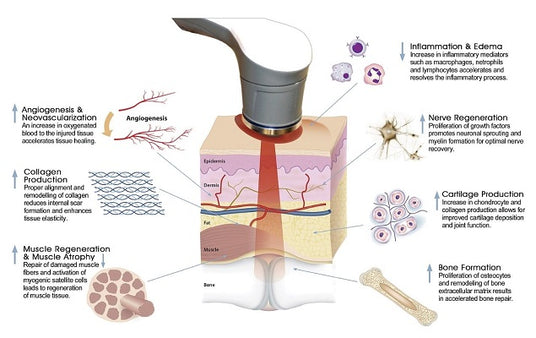
How does it work?
All light is composed of photons – small packets of light energy.
However, not all light is the same. Different electromagnetic wavelengths represent different colors on the visible light spectrum.
When light is projected as a single, coherent wavelength where the waves travel parallel to each other, it’s considered laser light.
Laser therapy applies specifically calibrated laser light to an organism in order to stimulate cellular level metabolic processes.
The photon energy of laser light can effectively penetrate the skin and underlying structures, accelerating the body’s natural healing process.
Laser therapy utilizes the wavelengths and frequencies of visible red and near infrared (NIR) light to treat a variety of conditions at their source within the body through safe, non-invasive, and painless procedures.

How does laser therapy affect the body?
During a laser therapy treatment session, visible red light and near infrared (NIR) are absorbed within the mitochondria and the cell membrane.
Studies have shown that when tissue cultures are irradiated by lasers, enzymes within cells absorb energy from laser light.
This produces higher ATP levels and boosts DNA production, leading to an increase in cellular health and energy.
Therefore, when applied as treatment, lasers have been shown to reduce pain and inflammation as well as stimulate nerve regeneration, muscle relaxation, and immune system response.
Lasers have no effect on normal tissues because photons of light are only absorbed and utilized by the cells that need them.
How laser therapy works
Health benefits of laser therapy
Accelerate cell repair
Accelerate cell repair
Accelerate tissue repair and promote cell growth
Photons of light from lasers penetrate deep into tissue and accelerate cellular reproduction and growth. The laser light increases the energy available to the cell so that the cell can take on nutrients faster and get rid of waste products.
As a result of exposure to laser light, the cells of tendons, ligaments, and muscles are repaired faster.
Expedite wound healing
Expedite wound healing
Heal your wounds on your own schedule
Laser light stimulates fibroblast development in damaged tissues.
Fibroblasts are the building blocks of collagen, which is predominant in wound healing. Collagen is the essential protein required to replace old tissue or to repair tissue injuries.
As a result, laser therapy is effective on open wounds and burns.
Immuno regulation
Immuno regulation
Help your body's natural lines of defense
Laser therapy has a direct effect on immunity status by stimulating immunoglobulins and lymphocytes.
Laser light is absorbed by chromophones (molecule enzymes) that react to laser light.
The enzyme flavin mononucleotide is activated and starts the production of ATP (adenosine triphosphate), which is the major carrier of cell energy and the energy source for all chemical reactions in the cells.
Improve nerve function
Improve nerve function
Slow recovery of nerve functions in damaged tissue can result in numbness and impaired limbs.
Laser light speeds up the process of nerve-cell reconnection and increases the amplitude of action potentials to optimize muscle action.
Improve vascular activity
Improve vascular activity
Laser light may significantly increase the formation of new capillaries in damaged tissue, speeding up the healing process, closing wounds more rapidly while also reducing scar tissue.
Additional benefits include acceleration of angiogenesis, which causes temporary vasodilatation, an increase in the diameter of blood vessels.
Increase metabolic activity
Increase metabolic activity
Laser therapy creates higher outputs of specific enzymes, greater oxygen, and food particle loads for blood cells.
Pain relief
Pain relief
Laser therapy has a high beneficial effect on nerve cells which block pain transmitted by these cells to the brain and which decreases nerve sensitivity.
Patients also experience less pain due to laser therapy's ability to reduce inflammation.
Another pain blocking mechanism involves the production of high levels of pain killing chemicals such as endorphins and enkephalins from the brain and adrenal gland.
Reduce fibrous tissue
Reduce fibrous tissue
Laser therapy reduces the formation of scar tissue following tissue damage from cuts, scratches, burns, or surgery.
Reduce inflammation
Reduce inflammation
Stimulate your anti inflammatory response
Laser therapy has an antiedemic effect as it causes vasodilation (the dilation of blood vessels, decreasing blood pressure).
It also activates the lymphatic drainage system to help drain swollen areas.
As a result, there is a reduction in swelling caused by bruising or inflammation.
Trigger & acupuncture points
Trigger & acupuncture points
Laser therapy stimulates muscle trigger points and acupuncture points on a non-invasive basis, providing musculoskeletal pain relief.







